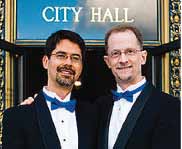 All summer long, it has been amazing to see the marriage map changing day by day as weddings performed by county clerks in New Mexico and Pennsylvania have proven once again that the marriage equality landscape has completely changed since the landmark U.S. Supreme Court rulings this June. Watching joyful couples lining up in county after county has been a wonderful reminder of the power we have on the local level to create national change – a lesson we learned almost a decade ago on the steps of San Francisco City Hall.
All summer long, it has been amazing to see the marriage map changing day by day as weddings performed by county clerks in New Mexico and Pennsylvania have proven once again that the marriage equality landscape has completely changed since the landmark U.S. Supreme Court rulings this June. Watching joyful couples lining up in county after county has been a wonderful reminder of the power we have on the local level to create national change – a lesson we learned almost a decade ago on the steps of San Francisco City Hall.
In February 2004, when San Francisco Mayor Gavin Newsom opened the doors of City Hall to marry all loving couples regardless of gender, it jump-started a movement and began the journey that led up to the U.S. Supreme Court ruling this June that restored marriage equality in California. Mayor Newsom stated, “Laws are made to be broken at times to find out if they are really legit or not.” San Francisco also maintained in court that it was enforcing the California constitution’s guarantees of equal protection, and thus answering a higher call when it defied the state statute restricting marriage to opposite-sex couples. Opponents of equality worried that the freedom to marry was spreading ‘like wildfire,’ as 2004 saw marriage licenses granted in places as diverse as New Paltz, New York; Multnomah County, Oregon; Sandoval County, New Mexico; and in Massachusetts.
The New Mexico marriages of 2013 began with an echo of the words of Gavin Newsom, as Doña Ana County Clerk Lynn Ellins declared, “I took an oath to uphold the Constitution.” Yet unlike in 2004, the marriages being performed in New Mexico today are not in defiance of state law; indeed, many of these marriages are taking place as a result of court orders finding it unconstitutional to deny marriage licenses to same-sex couples. In fact, New Mexico marriage law does not specify gender – so rather than acts of defiance, these weddings are acts of compliance with the state constitution, which prohibits this discrimination on the basis of sexual orientation in the words of one court: “Gay and lesbian citizens of New Mexico have endured a long history of discrimination. Denial of the right to marry continues this unfortunate, intolerable pattern and establishes irreparable injury on plaintiff’s part.”
Nationally, the marriages of 2013 are taking place in a transformed legal landscape thanks to the Windsor decision overturning Section 3 of DOMA – the U.S. Supreme Court holding that laws discriminating against married same-sex couples “have no legitimate purpose” and serve only to express “animus and disapproval,” which is not a constitutionally appropriate reason to make law. Justice Kennedy described couples with equal marriage rights as living “with pride in themselves and their union and in a status of equality with all other married persons.”
All across the country, echoes of Windsor are reverberating at the local level. In Pennsylvania, Montgomery County Register of Wills D. Bruce Hanes issued marriage licenses to same-sex couples, with the U.S. Supreme Court decision in mind, saying “I decided to come down on the right side of history and the law….” In Ohio, a federal judge ordered that state to honor the legal marriage of James Obergefell and John Arthur, who is dying of ALS, when the couple returned from their wedding in Maryland: “The purpose served by treating same-sex married couples differently than opposite-sex married couples is the same improper purpose that failed in Windsor and in Romer: ‘to impose inequality’ and to make gay citizens unequal under the law. It is beyond cavil that it is unconstitutionally prohibited to single out and disadvantage an unpopular group.”
County by county, and wedding by wedding, we are seeing couples and clerks and judges bringing to life in their actions the words of the U.S. Supreme Court’s Windsor decision “to protect in personhood and dignity,” not just in marriage, but also in all aspects of our lives. Justice Kennedy wrote: “Responsibilities, as well as rights, enhance the dignity and integrity of the person.” How fitting that almost exactly two months later, a New Mexico judge wrote: “There is no benefit to the parties or the public interest in having this matter progress through a lengthy path of litigation while basic constitutional rights are being compromised or denied on a daily basis.” What a wonderful reminder that as we celebrate love and marriage in more states than ever before, in the end, the marriage cases are about so much more than marriage – they are about our full humanity.
John Lewis and Stuart Gaffney, together for nearly three decades, were plaintiffs in the California case for equal marriage rights decided by the California Supreme Court in 2008. They are leaders in the nationwide grassroots organization Marriage Equality USA.
Recent Comments